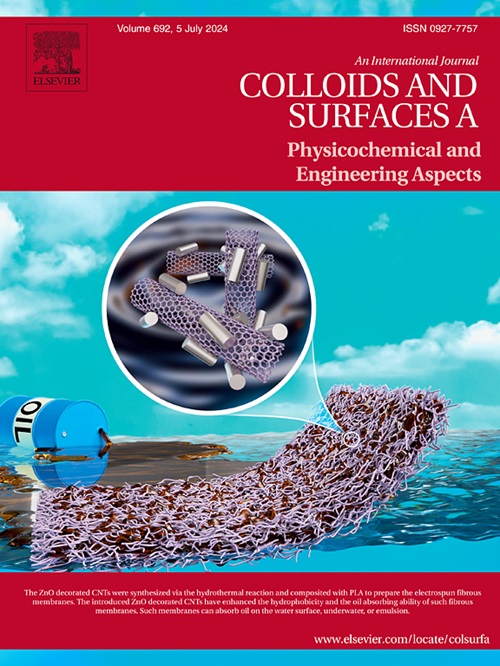Synergistic effects of mediated by different 1,2-epoxybutane addition numbers butoxylated alkyl block alcohol ethers and SDS in mixed systems
IF 4.9
2区 化学
Q2 CHEMISTRY, PHYSICAL
Colloids and Surfaces A: Physicochemical and Engineering Aspects
Pub Date : 2024-11-14
DOI:10.1016/j.colsurfa.2024.135753
引用次数: 0
Abstract
In this study, nonionic surfactant butoxylated alkyl block ether (AE9Bn) and anionic surfactant sodium dodecyl sulphate (SDS) with different BO additions were mixed at different molar ratios to make a hybrid system. The interaction parameters and aggregation behaviors of the blended systems were investigated by observing the average direct particle drop distribution and microscopic aggregates in combination with the results of static surface tension tests of the blended systems. The diffusion process of the mixed systems was investigated using dynamic surface tension tests. The dynamic contact angle and foam properties of the solutions of the mixed systems were also studied. Finally, based on the experimental results, it was concluded that the mixed system of AE9Bn (n=2,5) and SDS formed a synergistic effect that significantly led to a decrease in CMC, with an increase in the number of BO additions leading to a more significant decrease in CMC. The mixed system is a non-ideal mixed system, which is consistent with the kinetic mechanism of mixing and diffusion. The hybrid system has good aggregation pattern and wetting diffusion behavior and has low foam stability due to slow maturation of Ostwald.
不同 1,2-epoxybutane 加成数介导的丁氧基化烷基嵌段醇醚和 SDS 在混合体系中的协同效应
本研究将非离子表面活性剂丁氧基化烷基封端醚(AE9Bn)和阴离子表面活性剂十二烷基硫酸钠(SDS)以不同的摩尔比混合制成混合体系。通过观察混合体系的平均直接粒滴分布和微观聚集情况,并结合混合体系的静态表面张力测试结果,研究了混合体系的相互作用参数和聚集行为。利用动态表面张力测试研究了混合体系的扩散过程。此外,还研究了混合体系溶液的动态接触角和泡沫特性。最后,根据实验结果得出结论:AE9Bn(n=2,5)和 SDS 的混合体系形成了协同效应,显著导致 CMC 下降,BO 添加量的增加导致 CMC 下降更显著。混合体系为非理想混合体系,符合混合和扩散的动力学机制。混合体系具有良好的聚集模式和润湿扩散行为,但由于奥斯特瓦尔德成熟缓慢,泡沫稳定性较低。
本文章由计算机程序翻译,如有差异,请以英文原文为准。
求助全文
约1分钟内获得全文
求助全文
来源期刊
CiteScore
8.70
自引率
9.60%
发文量
2421
审稿时长
56 days
期刊介绍:
Colloids and Surfaces A: Physicochemical and Engineering Aspects is an international journal devoted to the science underlying applications of colloids and interfacial phenomena.
The journal aims at publishing high quality research papers featuring new materials or new insights into the role of colloid and interface science in (for example) food, energy, minerals processing, pharmaceuticals or the environment.

 求助内容:
求助内容: 应助结果提醒方式:
应助结果提醒方式:


